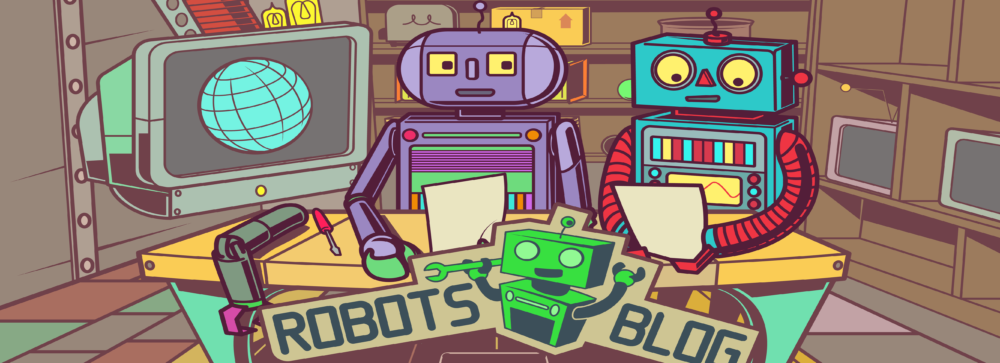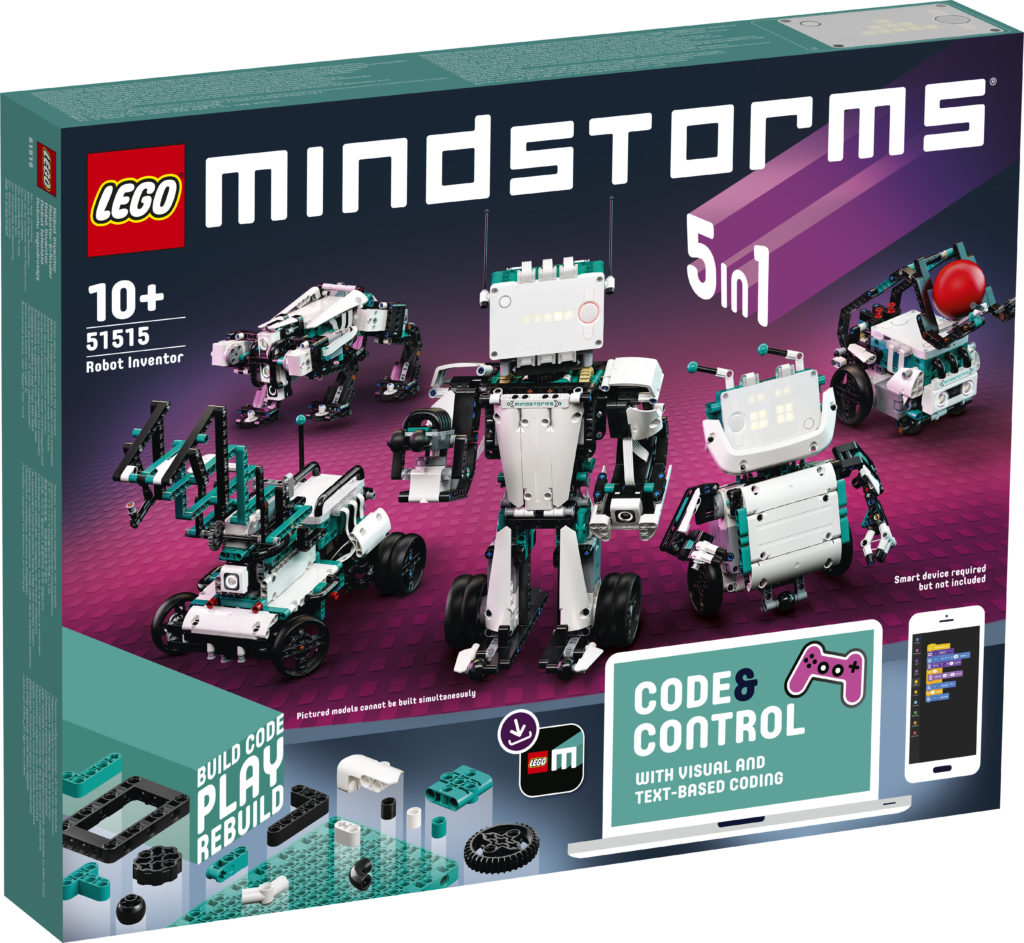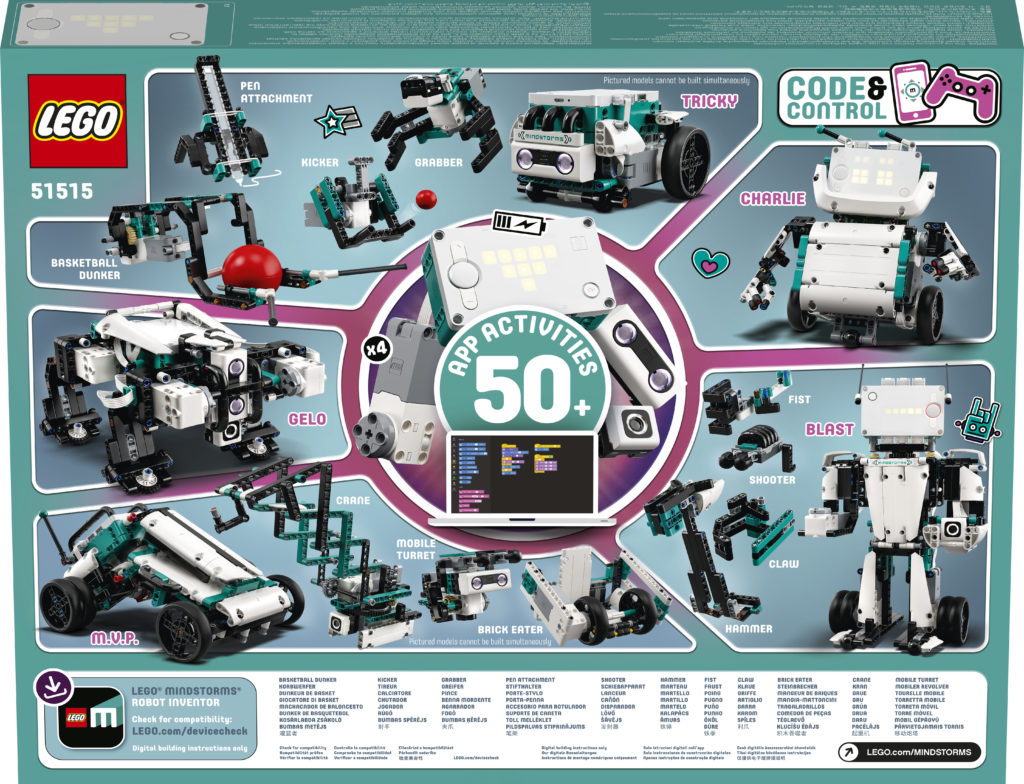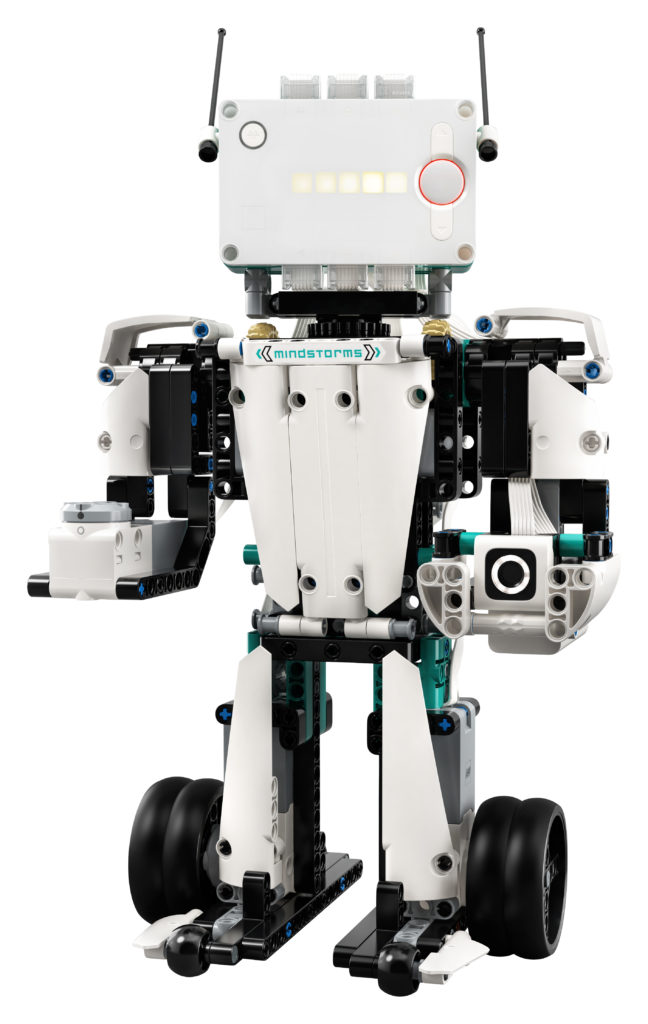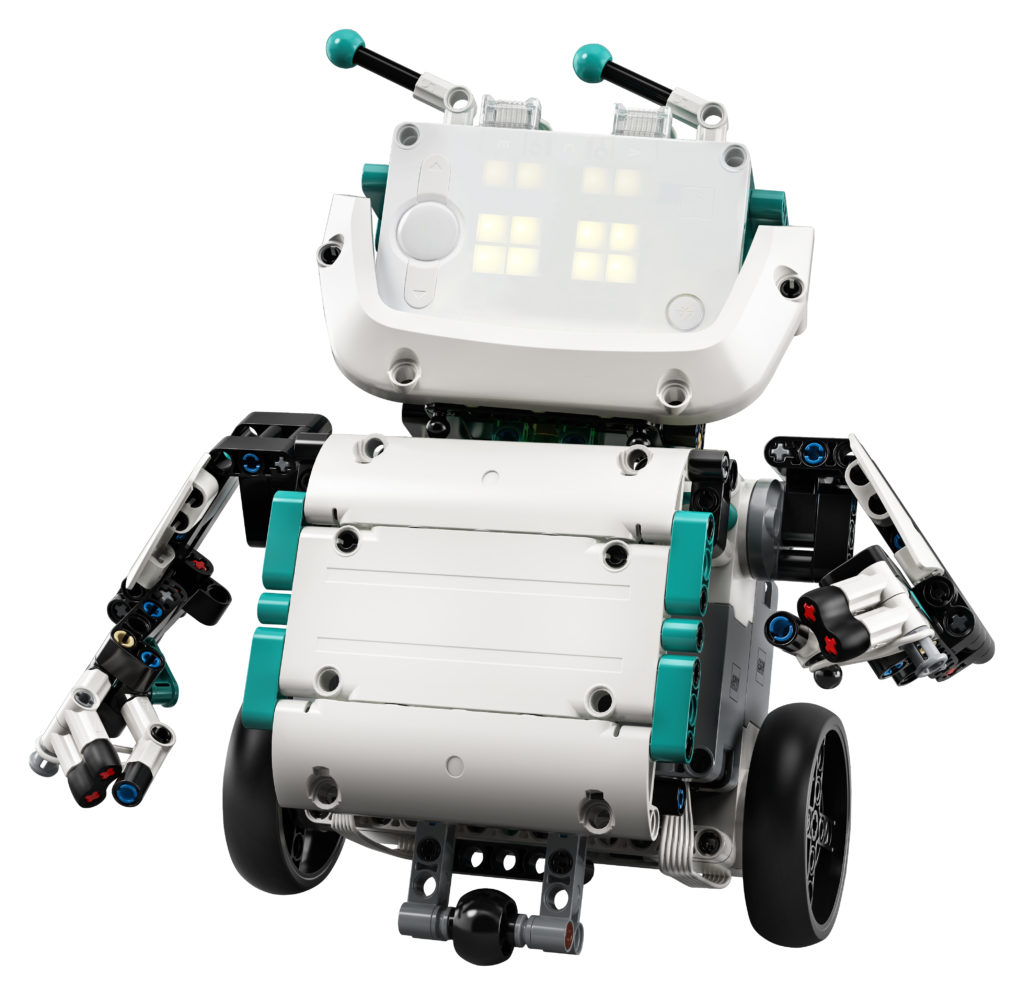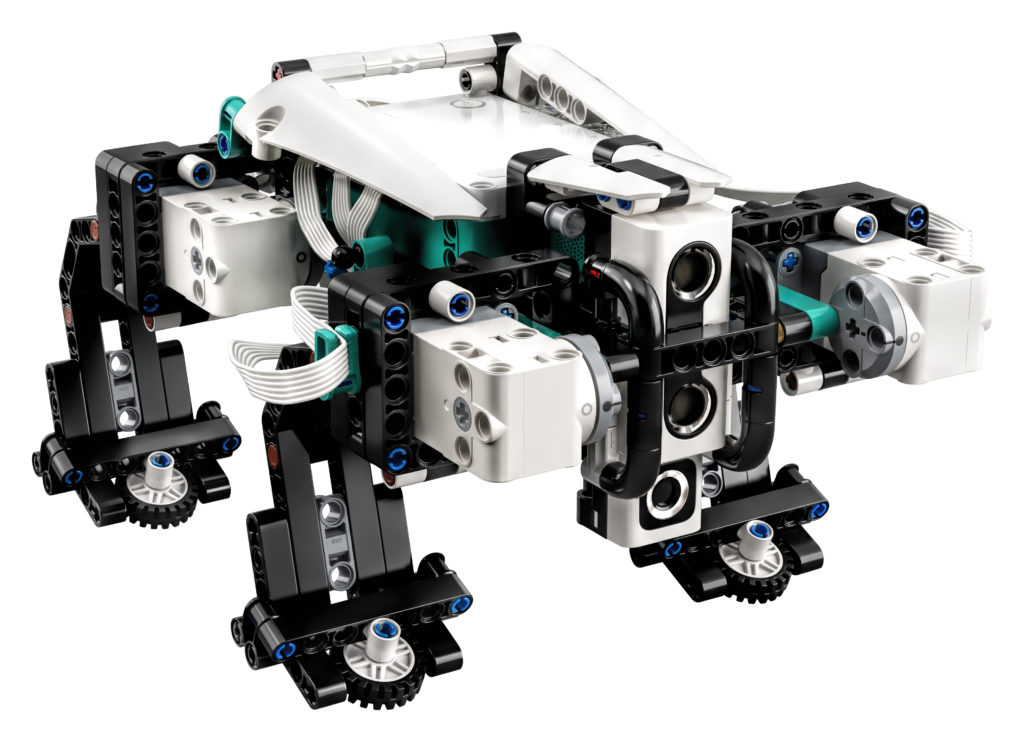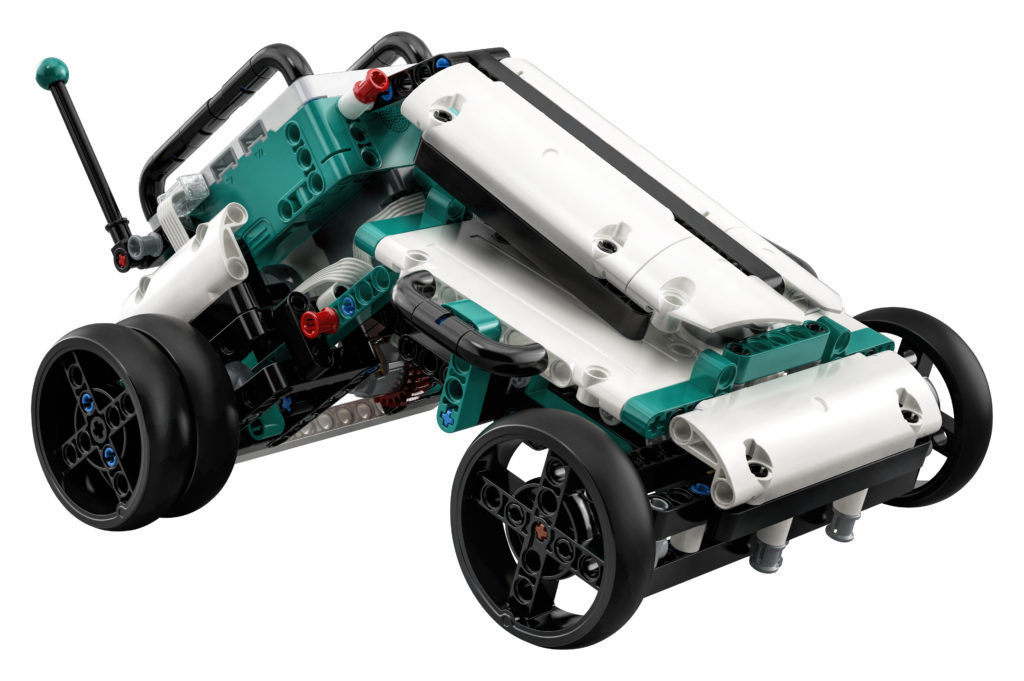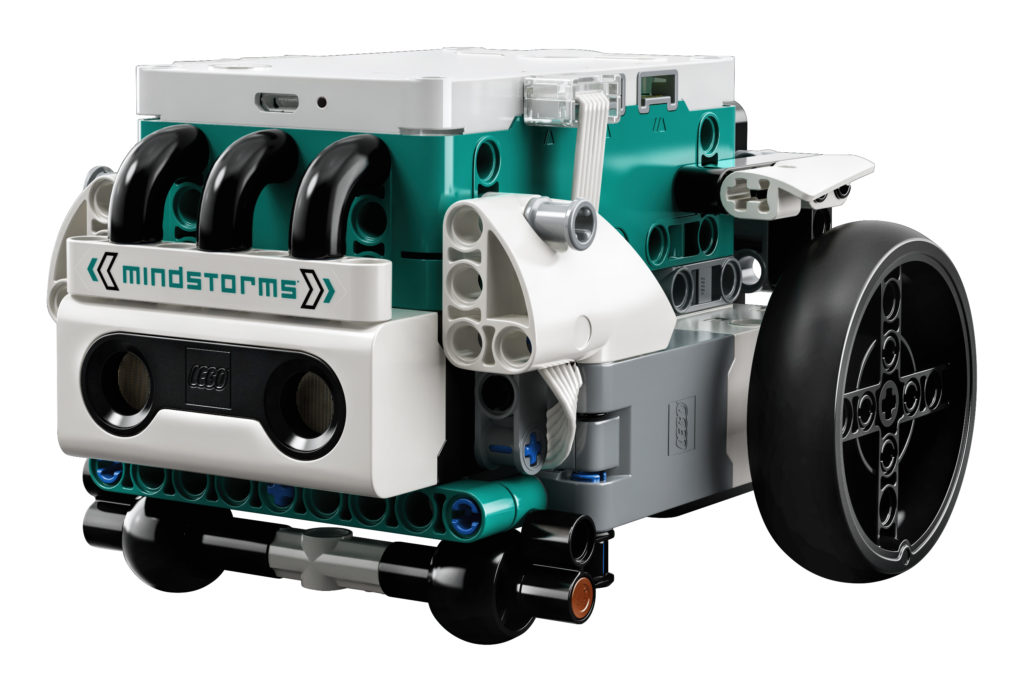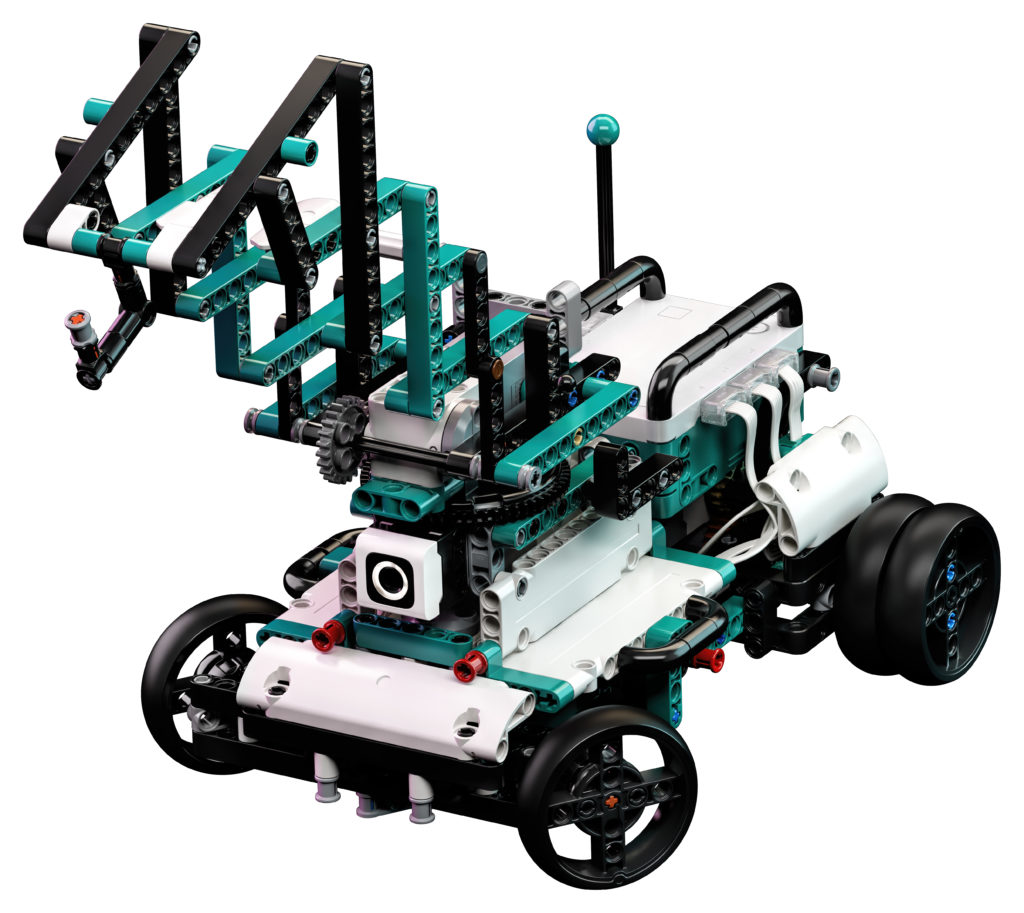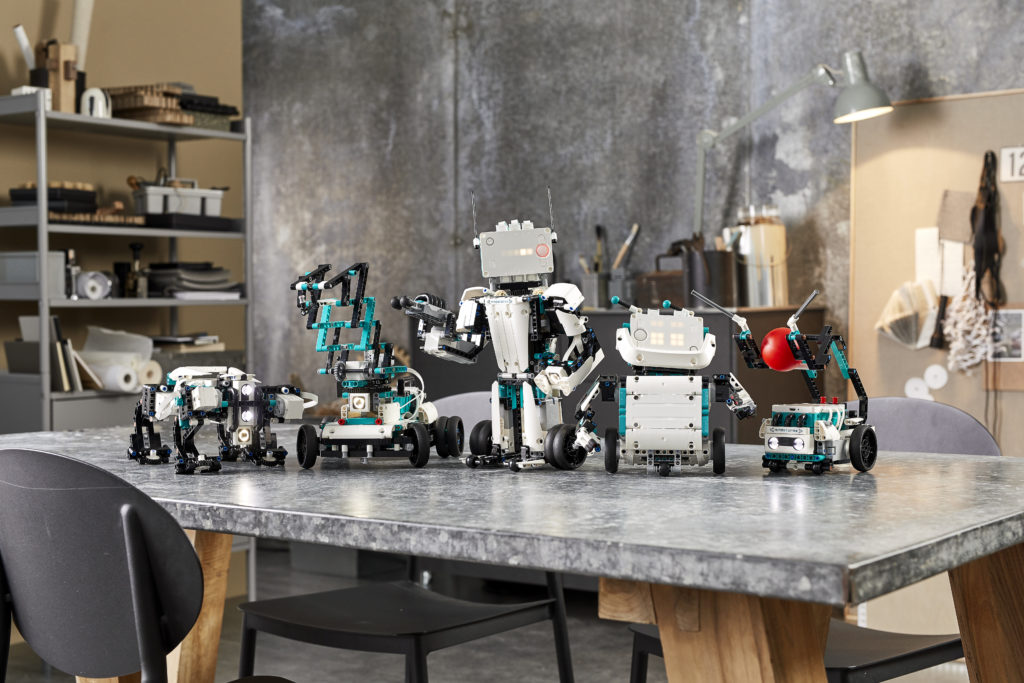Archiv der Kategorie: Hardware
New LEGO® MINDSTORMS® Robot Inventor lets creators build and bring to life anything they can imagine
- Builders can create and code one of five personality-packed robots or dream-up and build their own creations
- Robot Inventor uses drag-and-drop coding language based on Scratch as well as Python to support those new to robotics
- Over 50 new challenges and fun activities to help all abilities build coding confidence in a fun, exciting way
June 12th, 2020 – Billund: Today, the LEGO Group has announced the first addition to the much-loved LEGO® MINDSTORMS® theme in seven years. The new LEGO MINDSTORMS Robot Inventor 5-in-1 set unleashes a new world of fun, creative coding possibilities and provides the ultimate playful learning experience for young inventors and creators.
For over two decades, LEGO MINDSTORMS has inspired those of all ages to test and build their confidence with technology through play. By combining the LEGO building system with robotic and coding elements, builders can create anything they can imagine, while developing the STEM skills that 7 in 10 parents say are essential to their child’s future success.
This latest evolution of the much-loved theme continues this commitment to helping children develop STEM skills in a fun and exciting way at home. The new LEGO MINDSTORMS Robot Inventor 5-in-1 model gives builders aged 10+ the power to bring one of the set’s five unique designs to life or take their own builds to the next level by programming them to walk, talk, think and do more than ever before. Kids can also code their own remote-control features for the models in the LEGO MINDSTORMS Robot Inventor app or connect their own controllers to the app using Bluetooth.
Packed with 949 pieces and new LEGO Powered UP components, the LEGO MINDSTORMS Robot Inventor will be available in Autumn 2020 from LEGO.com, LEGO Retail Stores and retailers globally. The LEGO MINDSTORMS Robot Inventor 5-in-1 set will be priced at £329.99/$359.99/€359.99 and includes digital building and coding instructions for these five unique robots:
- Blast – this master robot is a stoic action hero. It can fire or hammer its way through obstacles and grab items. Builders can be the ultimate commanders, programming it to scan its environment and fire darts if it senses danger. Perfect for guarding your room!
- Charlie – this quirky sidekick helper can give out high fives, dance, play the drums, deliver small gifts, and charm friends with its smile.
- Tricky – the sporty bot is the ultimate athlete. Code it to complete the perfect slam dunk or master a plethora of robot sports: basketball, bowling or soccer – the list goes on and on.
- Gelo – a real life four-legged robot. Its unique mechanism means it can walk, avoid obstacles, and even perform tricks.
- M.V.P. – The Modular Vehicle Platform gets the job done. Create and code your own remote control and build the M.V.P. into a buggy, a crane, a shooter turret or even a brick-eating truck to pick up LEGO bricks left by the other robots.
Lena Dixen, Head of Product and Marketing Development at the LEGO Group, commented: “Since the launch of LEGO MINDSTORMS over 20 years ago, we’ve been committed to helping children and adults develop STEM skills through play. We are extremely excited to introduce a new MINDSTORMS product that offers even more creative opportunities for those of all ages, and we thank our fans for continuing to show us what is possible with LEGO MINDSTORMS. We are continually inspired by the creations the community share with us and hope that the LEGO MINDSTORMS Robot Inventor inspires many more children and playful adults to explore the exciting world of robotics and coding.”
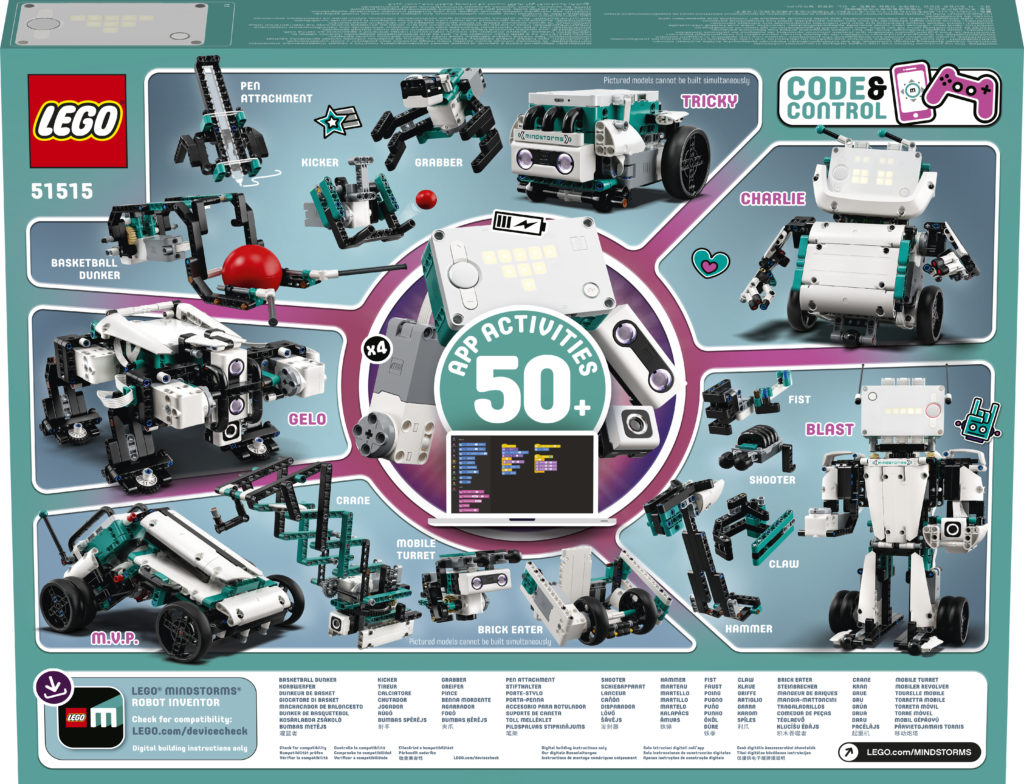
LEGO® MINDSTORMS® Robot Inventor (51515)
The LEGO® MINDSTORMS® Robot Inventor Kit is intended for builders and coders ages 10+ to discover and expand on their STEM skills at home.
- 949 pieces
- 5 unique models to build and code
- The largest robot Blast stands at over 14” (36 cm) tall
- The free LEGO® MINDSTORMS® Robot Inventor coding app for kids uses coding language based on Scratch and supports Python for more advanced coders.
- The application works across PC Windows 10 + macOS, iOS and Android tablets and smartphones as well as specific Fire OS devices.
New elements:
The new Intelligent Hub is an advanced yet simple-to-use device featuring 6 input/output ports for connecting a variety of sensors and motors. The Hub can also be used with LEGO Technic and System elements to create fun robots, dynamic devices and other interactive models.
- LED 5×5 matrix
- Bluetooth connectivity
- 6 axis gyro/accelerometer
- Includes a micro USB port for connectivity with compatible devices
- Speaker
- Rechargeable Lithium-ion battery included
Colour sensor – able to distinguish between eight colors and measures reflected and ambient light from darkness to bright sunlight
Distance sensor – detects obstacles, programmable LED ‘eyes’ and an integrated 6-pin adaptor for third-party sensors, boards and DIY hardware.
4 x medium-angular motors feature low-profile design, integrated rotation sensor with absolute positioning
New 7 x 11 teal baseplate
New black wheels
New frames
The STEMBoT Educational Robot Engages and Empowers Students
Here at STEMBoT Inc (SBI), we design super fun educational robots and tools that make learning things like math and computer programming exciting! STEM (science, technology, engineering, math) is the future and our product, the STEMBoT 2, is the best tool to stimulate students to want to learn at school and at home. The STEMBoT 2 Kickstarter launched on April 8th, has raised over $10,000 and has already reached its fundraising goal!
After nearly a decade of success at the University of Nebraska at Omaha, and several other high-level institutions, we have decided to redesign and share our educational robot, the STEMBoT, with the ever-growing STEM education market. We believe that all students should have ample opportunity to realize their potential. STEMBoTs have engaged thousands of students in computer programming, geometry, learning language prepositions, civil rights movements, and so much more. “We already have four high school students that want to enter into engineering because of their experience with the STEMBoTs. I’ve seen such a huge difference in my kids. Both at school and in their personal lives.” - Susan De Roy, Robotics Club @ Willa Cather Elementary
STEMBoTs are a powerful engagement tool for students, and are very easy for teachers to use. With our long term STEM education partners and your support, SBI is excited to get the STEMBoT into every school in the United States by 2030.
The STEMBoT 2 is a highly robust product that is suitable for Kindergarten- to College-level users. “The system is powered by an ARM Cortex-M4 microcontroller pre-programmed with MicroPython, a Python 3 interpreter developed for embedded systems.” – Logan McIntyre, Lead Engineer of STEMBoT Inc. The STEMBoT that students use to add fractions in elementary school is the same STEMBoT that students also use to master python programming in high school and college. We think that’s pretty cool.
Make A Robot Kit – Accessible yet Intelligent, MARK is where you start your AI education journey
Parents & educators worldwide understand the importance of equipping the next generation with vital skills of the future – robotics, coding & AI. However there is a lack of resources which make learning about artificial intelligence accessible, hands on & fun! So TinkerGen has developed a kit which provides a learning experience for kids and hobbyists.
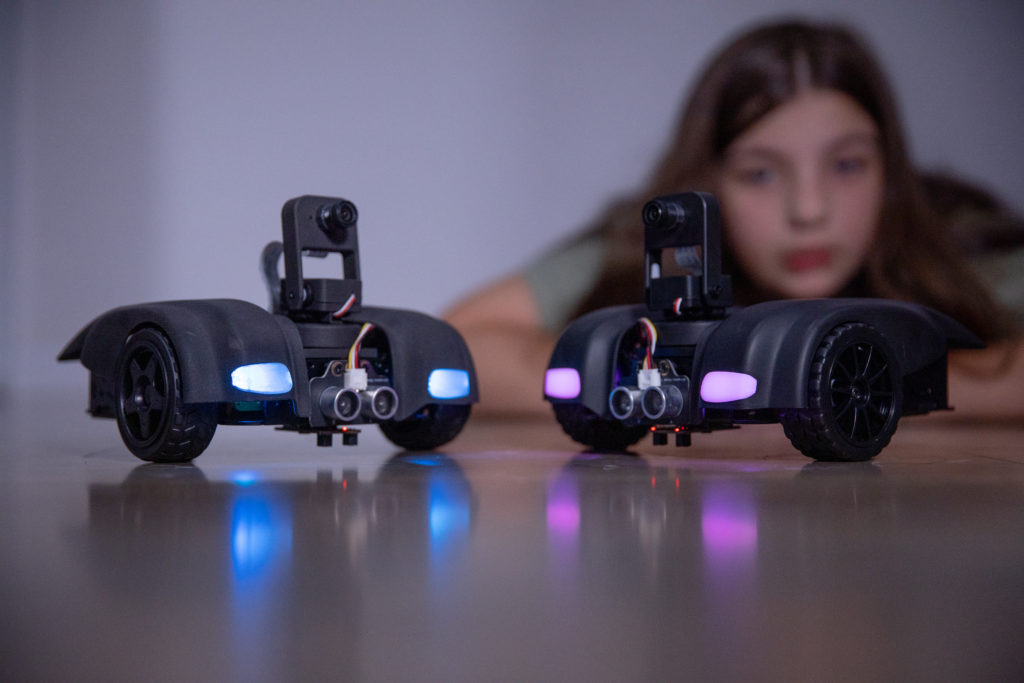
Make A Robot Kit, aka MARK, is an artificial intelligence robot which allows learners to achieve an exciting range of applications, from interacting with pet animals to experimenting with how autonomous vehicles work.
Supported with an abundant range of course materials, beginners start with a hands on assembly of their own robot, moving onto graphically coding their MARK to implement a self-driving car through street sign recognition & collision avoidance. As stated by MARK developer & TinkerGen course designer Dmitry Maslov, a main feature of MARK is, “making machine learning concepts and workflow more transparent, easier to understand and use for teachers and students.”
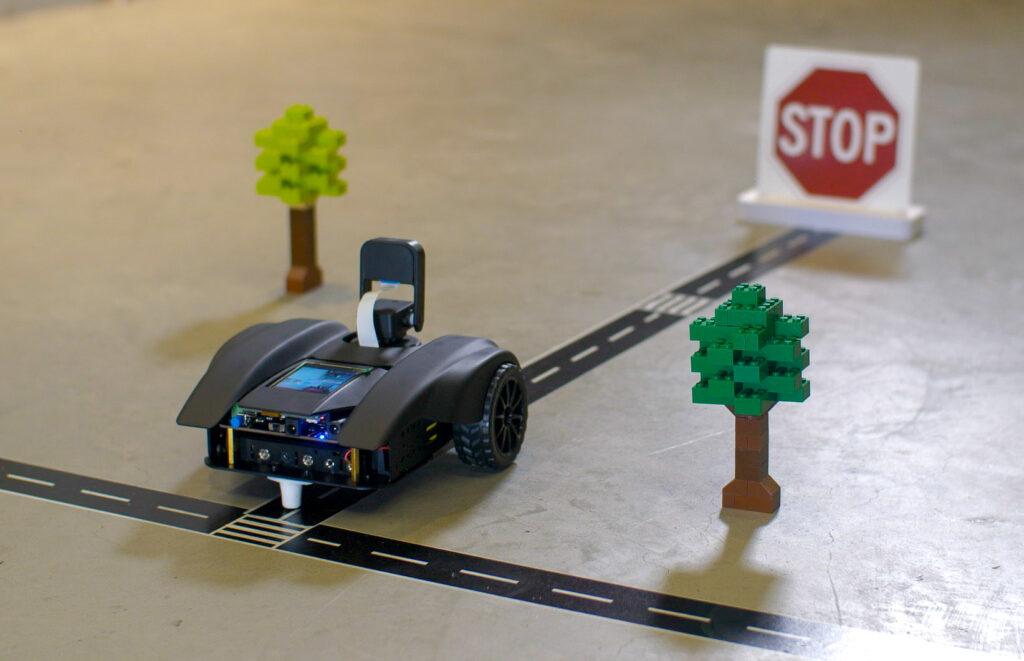
An electromagnetic attachment allows sorting application which teaches kids the concept of automated logistics. While 5 pretrained model categories are included so many applications can be easily and quickly implemented, students will also be able to train their own image recognition models.
The pretrained model categories include:
- road signs
- domestic animals
- zoo animals
- common objects
- Numbers
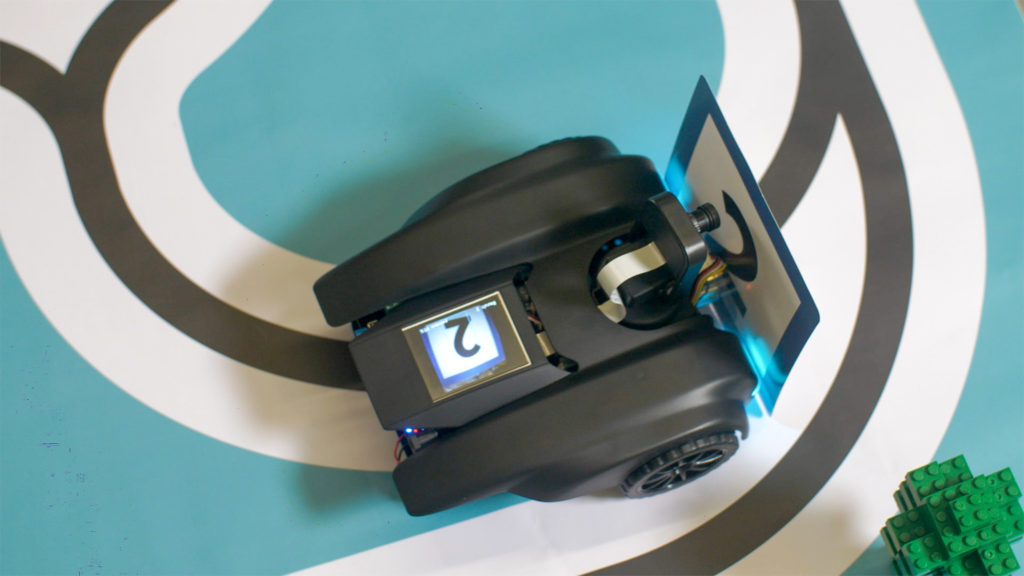
With slingshot and grabber attachments, and the ability to recognise almost any object, a whole new world of play is discovered. The whole family can get involved, multiple MARKS can battle in a sumo style fight, breeding productive competition, On the other hand, you could use MARK to feed, amuse and tease your pet with treats.
Features to Highlight:
- Machine Vision Capability
- Object & Image recognition
- Self driving car application
- Interactive with humans, pets, and the environment
- Graphical programming support
- Develops hands on robotics skills
- Extendible & Customisable
- Attachment points for accessories
- Connection ports for extra input/output modules
About TinkerGen:
TinkerGen is a STEM Education company which grew from an open source hardware manufacturer in Shenzhen – Seeed Studio, so we know our tech, but we’re here to serve the education community. We make the process for educators convenient, so kids can quickly get to the fun mind expanding bits of tinkering and creating! We believe that helping kids to develop STEM skills is really beneficial for their future, and also a proven way to bridge the privilege gap that unfortunately exists in our society today.
Maker-Spirit in Corona-Zeiten – Erste weltweite virtuelle Maker Faire am 23. Mai
Hannover, 7. Mai 2020 – Aufgrund der Corona-Pandemie wurden nahezu alle Maker Faires in 2020 abgesagt. Darunter auch die achte Maker Faire Hannover, die vom 12. bis 13. September im HCC geplant war. Statt von Angesicht zu Angesicht treffen sich die Maker jetzt online. Das US-Maker-Faire-Team organisiert am 23. Mai ein 24-Stunden-Event, bei dem die Macher aus aller Welt ihre Ideen virtuell vorstellen können. Im Fokus stehen dabei die Covid19-Projekte.

Deutschlands größtes DIY-Festival, das sich in Niedersachsens Hauptstadt in den vergangenen Jahren zu einem Publikumsmagneten für die ganze Familie entwickelt hat, wurde auf den 11. und 12. September 2021 verschoben. „Leider werden wir die Maker Faire Hannover in der aktuellen Situation nicht wie geplant durchführen können. Somit haben wir uns schweren Herzens dazu entschieden, die Veranstaltung in diesem Jahr auszusetzen“, bedauert Daniel Rohlfing, Leiter Events und Sales, Maker Media. Im vergangenen Jahr bestaunten in Hannover 17.500 Besucherinnen und Besucher die vielen spannenden Ideen der internationalen Maker-Szene.
Einfach machen
Mit ihren unkonventionellen Erfindungen machen die Makerinnen und Maker gerade in der Corona-Zeit von sich reden. Weltweit hat die Community auf den Mangel an medizinischer Versorgung und Ausrüstung reagiert. Die Macher haben ihre 3D-Drucker und ihre Nähmaschinen aktiviert und mit ihrem ganz eigenen Spirit gemeinsam innovative Produkte geschaffen.
Drucken gegen Corona
In Deutschland ist das beispielsweise die Initiative „Maker vs. Virus“. Hier haben sich etliche Maker und Fablabs zusammengeschlossen, um sich gegenseitig zu unterstützen und ihre Ressourcen besser zu organisieren – etwa bei der 3D-Druck-Fertigung von Gesichtsschutzmasken, den sogenannten Face Shields. Im Rahmen des WirvsVirus-Hackathons von der Bundesregierung hat ein interdisziplinäres Maker-Team sogar ein komplettes Beatmungsgerät als Prototyp entwickelt.
Maker-Spirit im Netz erleben
Diese Covid19-Projekte stehen auch im Fokus der ersten virtuellen Maker Faire, die am Samstag, den 23. Mai, als 24-Stunden-Event weltweit in allen Zeitzonen vom US-Maker Faire-Team organisiert wird: der Bildschirm als Bühne für die einfallsreichen Konzepte und ihre Macher. Auch das deutsche Maker Media-Team beteiligt sich an der digitalen Show. Weitere Infos gibt es hierzu unter: makerfaire.com. Wer dabei sein will, kann sich hier anmelden: https://makerfaire.com/virtually-maker-faire-call-2020-for-makers/
Auf dem Laufenden bleiben
Wer sich für die Maker-Bewegung interessiert, kann sich auf der Webseite www.maker-faire.de auf dem Laufenden halten. Ein monatlicher Newsletter informiert über aktuelle Themen, neue Termine und allgemeine DIY-Nachrichten. Folgen Sie uns auch auf Facebook, Twitter und Instagram .
Alle Maker Faires in D/A/CH werden vom deutschsprachigen Make Magazin präsentiert.
Lenovo Robot Vacuum T1
Leistungsstarker Saugroboter schafft mehr Zeit für die schönen Dinge des Lebens
 Der neue Robot Vacuum T1 von Lenovo |
| Berlin, 21. April 2020 – In puncto Zeitersparnis und Komfort sind Saugroboter wertvolle Helfer im Haushalt. Mit dem Robot Vacuum T1 hat der Technologieexperte Lenovo sein Portfolio um einen innovativen Wisch- und Saugroboter mit automatisierter Entladungsfunktion erweitert. Der leistungsstarke Haushaltshelfer ist ab sofort im Handel erhältlich. |
| Der Robot Vacuum T1 sorgt selbstständig für staub- und schmutzfreie Räume. Der Nutzer wählt ganz bequem ob er staubsaugen, wischen oder beide Reinigungsfunktionen kombinieren will. Die gewünschte Reinigungsfunktion kann praktisch via App auf den jeweiligen Bedarf und die Raumverhältnisse angepasst werden. Die smarte Steuerung ist auch über Alexa und Google Assistant möglich. |
| Automatisierte Entladungsfunktion |
| Mit dem 5200mAh starken Li-Ionen-Akku gelingt eine Reinigungszeit bis zu 150 Minuten und damit eine Reichweite von bis zu 200 Quadratmetern. Ist der Akku leer, fährt der Robot Vacuum 1 automatisch zur Ladestation zurück. In vier bis fünf Stunden ist der Akku vollständig aufgeladen und führt automatisch das Reinigungsprogramm zu Ende. In der Pro-Variante ist zudem eine automatisierte Entladungsfunktion für den aufgesaugten Schmutz in der Ladestation eingebaut. |
 |
| Automatisierte Entladungsfunktion bei der Pro-Variante |
| Intelligente Steuerung und Orientierung |
| Insgesamt 29 Sensoren sorgen für intelligente Steuerung und Orientierung im Raum. Lenovo verbaut eine LDS-Laser-Navigation, die es dem Robot Vacuum T1 ermöglicht, die Entfernung zu Hindernissen genau zu berechnen. Der integrierte Kantensensor warnt vor Treppenstufen und bremst rechtzeitig ab. Auch kleinere Hindernisse wie Türschwellen, Kabel oder Teppichböden stellen keine Hürden dar. In Zahlen ausgedrückt, schafft der Saugroboter eine Steigfähigkeit von bis zu 20 Millimetern. |
| Design mit Funktion |
| Die Höhe des Staubsaugerroboters fällt mit 98 Millimetern gezielt flach aus. So kann der Wisch- und Saugroboter unter Möbel fahren und damit auch unter Sofa oder Bett für einen sauberen Boden sorgen. Insgesamt sind bei dem innovativen Saug- und Wischroboter alle Komponenten auf wenig Raum verbaut: Mechanik, Technik, Staubbehälter (400ml), Wassertank (110ml) sowie Akku-Technologie des Roboters finden auf 350/350/98 Millimeter Platz. |
| Der Robot Vacuum T1 ist ab sofort bei cyberport erhältlich. |
| Weitere Informationen unter www.tekpoint.com |
Kosmos Roboter Monty wird zum Seiltänzer
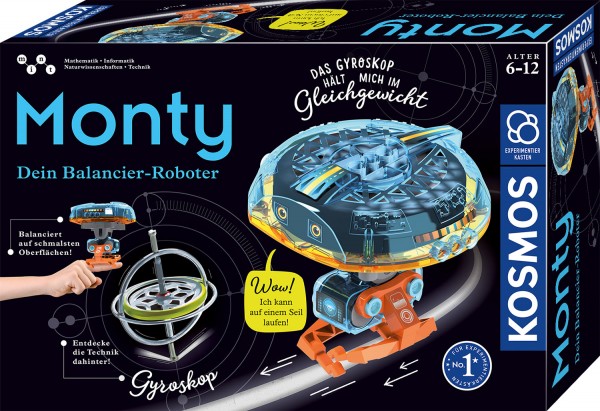
Roboter Monty ist ein wahrer Balancierkünstler: Problemlos läuft der kleine
Balancier-Roboter auf einem schmalen Seil, ebenen Flächen oder einem
Finger entlang! Sein Geheimnis: ein Kreiselinstrument – auch Gyroskop
genannt – das sich in seinem Kopf rasend schnell dreht. So bleibt Monty immer
im Gleichgewicht. Spielerisch lernen Kinder ab sechs Jahren so physikalische
Grundsätze kennen.
Kinder bauen den Balancier-Roboter Monty und den mitgelieferten Balancierrahmen
aus den KOSMOS Systembauteilen selbständig zusammen. Mit Hilfe der farbig
illustrierten Anleitung ist der Aufbau ein Kinderspiel und in wenigen Minuten erledigt.
Auf den Nachgehaktseiten finden die jungen Forscher spannende Versuche zu dem
Gyroskop in Montys Kopf und erfahren mehr darüber, wo die Gyro-Technik im Alltag
eingesetzt wird. Außerdem erweckt ein spannendes Comic-Abenteuer den kleinen
Roboter zum Leben. Mit seinen verblüffenden Fähigkeiten bietet Monty einen
spannenden Einstieg in das Thema Robotik und Physik.
Inhalt: Roboter aus Kosmos-Systembauteilen, im Kopf des Roboters eingebautes
Gyroskop, Motor, Balancierseil, Balancierrahmen aus Kosmos-Systembauteilen,
Sticker-Set zum Bekleben, Anleitung (20 Seiten)
https://www.kosmos.de/experimentierkaesten/roboter-programmieren/11000/monty
Kosmos Roboter-Arm Modellbausatz
Präzision und Schnelligkeit
Mit Experimentierkasten Roboter-Arm selbst bauen und steuern
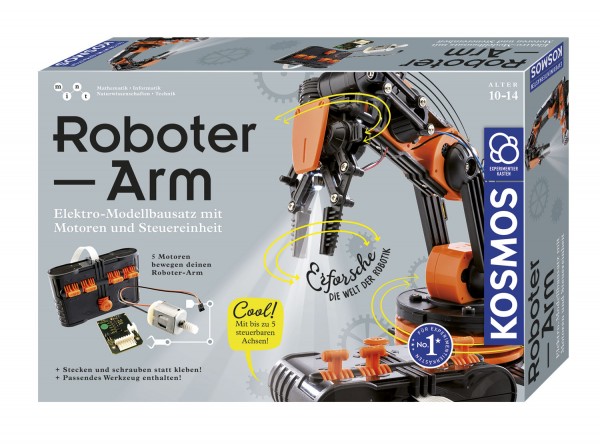
Der Roboter-Arm schwirrt durch die Luft, greift nach einem Bauteil, setzt dieses exakt ab – und wieder geht’s von vorne los. Die Präzision und Schnelligkeit sind beeindruckend – auch in der Miniatur im Kinderzimmer. Mit dem neuen KOSMOS Experimentierkasten Robotor-Arm können Nachwuchsingenieure ab zehn Jahren ihren eigenen Robotor-Arm zusammenbauen und steuern.
Die anschauliche Anleitung beschreibt Schritt für Schritt wie aus dem Modellbausatz Achsen, Motoren und Greifer entstehen. Ganz ohne Klebstoff werden die Kunststoffelemente gesteckt, geklickt oder geschraubt. Geschafft! Im zweiten Schritt entsteht aus den Elektronikbauteilen und der Steuerplatine der Controller. Damit lassen sich die Achsen und Motoren millimetergenau steuern und die LED im Greifarm schalten. Jetzt ist es an der Zeit, den Roboter in Betrieb zu nehmen. Die Anleitung beschreibt alle möglichen Bewegungen, die der RoboterArm ausführen kann – aber auch, welche Fehlerquellen auftreten könnten.
https://www.kosmos.de/experimentierkaesten/physik-elektronik/10316/roboter-arm
Zukunftstechnologie fürs Kinderzimmer – Chipz von Kosmos
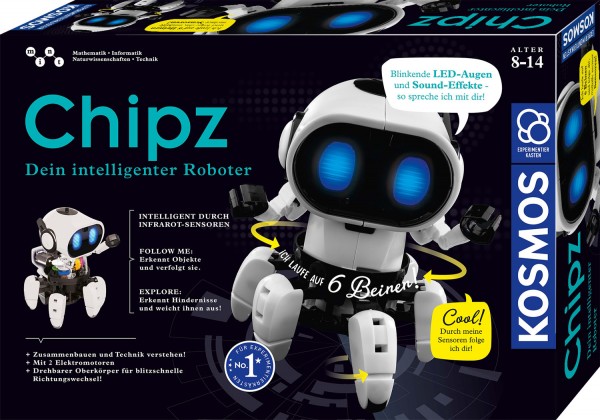
Wer hätte gedacht, dass es so einfach ist, seinen eigenen Roboter zu erschaffen? Denn der intelligente, sechsbeinige Roboter Chipz wird selbständig von jungen Nachswuchsforschern zusammengebaut – und bietet dann zahlreiche Interaktionsmöglichkeiten. Zwei unterschiedliche Bewegungsmodi sowie Licht- und Soundeffekte machen Chipz zu einem sympathischen elektronischen Begleiter, mit dem Kinder spielerisch MINTThemen entdecken. Chipz kann sich auf seinen sechs Beinen selbständig im Raum fortbewegen. Wie das funktioniert? Im „Follow-me-Modus“ erkennt der Roboter durch seine InfarotSensoren Objekte, denen er folgt. Stellt man auf den Modus „Explore“ um, helfen Chipz Sensoren bei der Hindernis-Erkennung. Dadurch kann er sich ohne Hilfe den Weg aus einem Labyrinth bahnen oder sich im Raum zurechtfinden, ohne anzustoßen. Durch blinkende LED-Augen und Sound-Effekte kommuniziert der Roboter mit seinem Besitzer und macht auf sich aufmerksam. Zusätzlich erweckt die enthaltene Comic-Geschichte Chipz zum Leben. Selbstverständlich muss der Roboter zuerst noch zusammengebaut werden, was ein wenig motorisches Geschick erfordert und trainiert. Doch mithilfe der ausführlichen Anleitung meistern Kinder ab acht Jahren den Zusammenbau problemlos und begreifen nebenbei die dahinterstehende Technik.
Material: Über 100 Teile zum Zusammenbau des Roboters, u.A. vorprogrammiertes Board mit Infrarot-Sensoren und zwei Elektromotoren. Inkl. kleinem Kreizschlitz-Schraubendreher. 4 AAA-Batterien sowie eine Schere oder Zange werden zusätzlich benötigt.
https://www.kosmos.de/experimentierkaesten/roboter-programmieren/10324/chipz
Sarcos Robotics Partners with Delta Air Lines to Bring First Public Demonstration of Guardian XO Full-Body, Force-Multiplying Industrial Exoskeleton Robot to CES 2020
January 7, 2020 by Sarcos Media Coverage
Delta is first airline to explore first-of-its-kind wearable robotic exoskeleton to bolster employee strength and safety
LAS VEGAS, Jan. 7, 2020 – Delta Air Lines (NYSE: DAL) is partnering with Sarcos Robotics to explore new employee technology fit for a superhero – a mobile and dexterous exoskeleton designed to boost employees’ physical capabilities and bolster their safety.
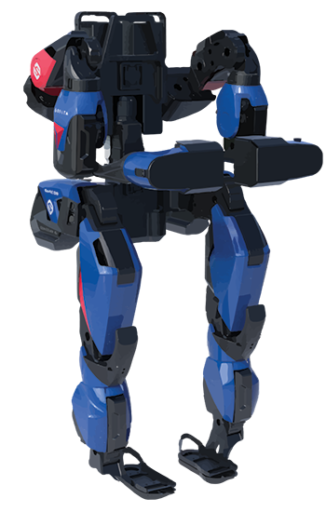
Sarcos, the world’s leader in exoskeleton development, has developed the Sarcos Guardian XO, a battery-powered, full-body exoskeleton designed to boost human performance and endurance while helping to prevent injury. This robotic suit, designed for employees to wear, does the heavy lifting. By bearing the weight of the suit and the payload, the exoskeleton may enable an employee to lift up to 200 pounds repeatedly for up to eight hours at a time without strain or fatigue.
“We owe it to the best airline employees on the planet to explore how emerging technology can make their jobs safer and easier,” said Gareth Joyce, Delta’s Senior Vice President – Airport Customer Service & Cargo. “That’s why we sought out a partnership with Sarcos.”
Delta is the first company whose frontline employees have worked directly with Sarcos to determine potential operational uses for the Guardian XO. In November, Delta people representing Airport Customer Service and Cargo visited the Sarcos headquarters to see it in action and explore how wearable robotics could potentially benefit them in their everyday work.
The Guardian XO is designed for use in industries where lifting and manipulation of heavy materials or awkward objects is required and isn’t easily handled by standard lift equipment. Potential uses at Delta could include handling freight at Delta Cargo warehouses, moving maintenance components at Delta TechOps or lifting heavy machinery and parts for ground support equipment.
Exploring how advanced tools and tech can better support employees is one way Delta aims to improve workplace safety while extending its industry lead in operational performance for customers.
Delta plans to test the technology in a pilot location during the first quarter of 2020, giving employees the opportunity to experience the tech in a real-world setting and provide additional feedback on its functionality. Watch Delta employees exploring Sarcos exoskeleton technology.
In addition to enabling superhuman strength for extended periods, the robotic suit may also level the playing field in terms of physical capacity. Roles that have historically been limited to those who meet specific strength requirements could potentially be performed by a more diverse talent pool, thanks to wearable robotics.
Ben Wolff, Sarcos CEO, said, “We look for companies who are clear leaders in tech adoption and have a history of innovating to meet the needs of their customers and their employees. Delta is the natural fit in the airline industry and has proven to be a great partner as we work to fine-tune this technology for commercial deployment.”
Delta first started working with Sarcos in 2018 as part of its “X-TAG”, or exoskeleton technical advisory group, representing the aviation sector. This council includes ten of the Fortune 100 across a variety of industries, including industrial manufacturing, oil and gas, utilities, logistics, construction, automotive, aviation, and aerospace.
At CES and want to see the Guardian XO for yourself? Stop by Delta’s booth (#14035) in Central Hall where attendees can get first-hand experience with the technology.
###
About the Guardian XO
The Sarcos Guardian XO exoskeleton represents the next step in the evolution of high-performance, highly dexterous, mobile robots that augment human performance. Sarcos Robotics is the first and only company in the world to produce a full-body, powered robotic exoskeleton that increases strength and endurance. The Guardian XO exoskeleton enables the operator to perform hours of physical activity that would otherwise be impossible for a single human to perform.
Because the Guardian XO exoskeleton supports natural, fluid, and intuitive movement, it requires relatively minimal operator training. A Guardian XO exoskeleton is capable of repeatedly lifting and supporting up to 200 pounds without fatigue or strain. The human operator bears none of the load of the exoskeleton, and only that portion of the payload that is necessary to enable the operator to understand that weight is being lifted. The Guardian XO exoskeleton can be donned and doffed in just 30 seconds.
Sarcos is now accepting orders for the Guardian XO exoskeleton and will deliver commercial production units in late 2020. For more information about Sarcos, the Guardian XO, and its other safety and productivity-enhancing robots, visit https://www.sarcos.com/company/.
About Sarcos Robotics
Sarcos Robotics is the world’s leader in industrial robotic systems that augment human performance by combining human intelligence, instinct, and judgment with the strength, endurance, and precision of machines to enhance employee safety and productivity. Leveraging more than 25 years of research and development, Sarcos’ mobile robotic systems, including the Guardian® S, Guardian® GT, and Guardian® XO®, are revolutionizing the future of work wherever physically demanding work is done. Formerly the robotics division of a major defense contractor, Sarcos is based in Salt Lake City, Utah, powered by an innovative team of entrepreneurs and engineers, and backed by Caterpillar, GE Ventures, Microsoft, and Schlumberger. For more information please visit www.sarcos.com.
About Delta
Delta is the U.S. global airline leader in products, services, innovation, reliability and customer experience. Powered by its 80,000 people around the world, the airline serves nearly 200 million people every year on more than 5,000 daily departures across its industry-leading global network to more than 300 destinations in over 50 countries. Over the past several years, Delta has led the airline industry in transforming the customer experience by introducing the first end-to-end biometric terminal in the US at Atlanta‘s international airport, real-time RFID bag tracking and automatic check-in via the Fly Delta mobile app, an alliance that will empower customers with seamless in-cabin connectivity experience, more efficient and high-tech automated screening lanes, and a groundbreaking app that helps Delta pilots avoid turbulence for a more comfortable flight. The global airline is also empowering its employees – Delta’s greatest competitive advantage – by arming them with handheld platforms that allow for more personalized service delivery and more meaningful interactions – not just transactions – with customers. All of this has resulted in Delta being named one of Fast Company’s Most Innovative Companies Worldwide two consecutive years, and Fortune’s Most Admired Airline for eight of the past nine years.
